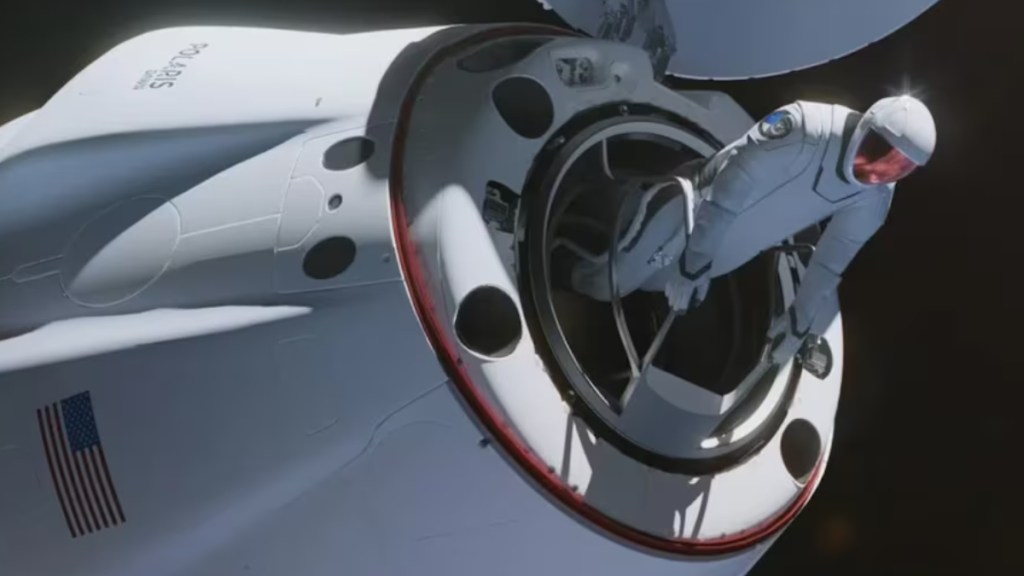In a groundbreaking step for private space exploration, billionaire tech entrepreneur Jared Isaacman returned to orbit on Tuesday, embarking on the Polaris Dawn mission, which aims to achieve the first private spacewalk. This mission marks a major milestone, with Isaacman and his crew set to venture farther into space than any human has since NASA’s Apollo moon missions.
Unlike his previous privately chartered spaceflight, Isaacman collaborated with SpaceX on the cost of this mission, which included the development and testing of new spacesuits. These suits are designed to withstand the harsh vacuum of space and will undergo rigorous testing during the spacewalk. If successful, this will be the first time private citizens perform a spacewalk, although they will remain tethered to the capsule.
Spacewalk Challenges
Spacewalks, considered one of the most dangerous aspects of space travel, have historically been conducted only by professional astronauts. Since the Soviet Union’s first spacewalk in 1965, and the U.S. following closely, spacewalks have become routine at the International Space Station (ISS). However, Isaacman and his team are venturing into uncharted territory for private individuals.
Launch and Mission Details
Isaacman, accompanied by two SpaceX engineers and a former Air Force Thunderbirds pilot, launched aboard a SpaceX Falcon 9 rocket from Florida. The mission includes a planned spacewalk on Thursday, the midpoint of their five-day journey. The crew will first aim to surpass the ISS, reaching an altitude of 870 miles (1,400 kilometres)—far beyond the record set by NASA’s Project Gemini in 1966. Only the 24 Apollo astronauts have ventured farther into space.
Testing the New Spacesuits
The crew will spend 10 hours at this extreme altitude, facing increased radiation and space debris before descending to a lower orbit. Even at 435 miles (700 kilometres), their orbit will be higher than the ISS and the Hubble Space Telescope. During the spacewalk, Isaacman and SpaceX’s Sarah Gillis will exit the capsule briefly to test the new white and black-trimmed suits. They will remain tethered to the capsule, avoiding any jetpack manoeuvres, which are reserved for NASA’s astronauts.
Crew Roles and Responsibilities
While Isaacman and Gillis test the suits outside, pilot Scott “Kidd” Poteet and SpaceX’s Anna Menon will monitor the spacewalk from inside the capsule. Like previous SpaceX astronaut flights, the mission will conclude with a splashdown off the coast of Florida.
“We’re sending you hugs from the ground,” Launch Director Frank Messina radioed after the crew reached orbit. Isaacman responded with gratitude, acknowledging the support of the 14,000 SpaceX employees involved in the mission. “We wouldn’t be on this journey without all 14,000 of you back at SpaceX and everyone else cheering us on.”
The Investment in Private Space Exploration
At a preflight news conference, Isaacman, founder and CEO of Shift4, declined to disclose the cost of the mission, joking, “Not a chance.” SpaceX’s vice president, William Gerstenmaier, highlighted the partnership’s importance in developing the spacesuits and advancing private sector space exploration.
This mission is the first of three that Isaacman purchased from Elon Musk’s SpaceX following his initial private spaceflight in 2021, which he bankrolled entirely. That trip, which included contest winners and a childhood cancer survivor, raised millions for St. Jude Children’s Research Hospital.
Extensive Training and Delays
Spacesuit development took longer than expected, leading to delays. The crew’s training, according to Poteet, was as rigorous as anything he experienced during his Air Force career. As SpaceX trainers, Gillis and Menon helped prepare Isaacman’s current and previous team, along with NASA astronauts.
Poor weather postponed the launch for two weeks, as favourable conditions were necessary not only for the launch but for the eventual splashdown. With limited supplies and no opportunity to dock with the ISS, the crew had to wait for ideal conditions.
Isaacman, 41, expressed his long-term vision for space exploration: “I wasn’t alive when humans walked on the moon. I’d certainly like my kids to see humans walking on the moon and Mars, and venturing out and exploring our solar system.”
With inputs from AP


